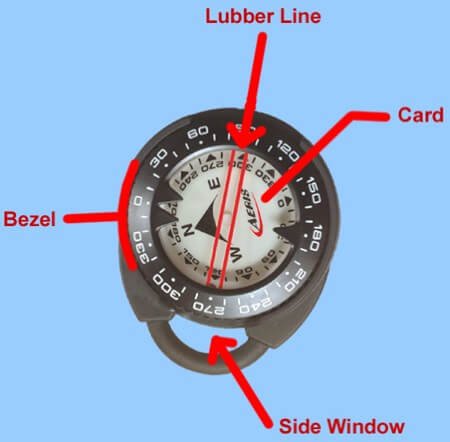Last Updated: February 27, 2023
Scuba diving enthusiasts must find it enthralling to explore the sea. Scuba diving requires you to go through an extensive course, where you will be learning the basics and some survival techniques.
A widespread doubt when exploring underwater is what the underwater navigation system is? Some divers use natural navigation when there is a stationary object while they dive, provided they are not planning to go far. Another method is navigating using a compass.
In this article, we will be shining light on how to use a compass in diving.

Can the Compass Used on Land be Used Underwater Too?
No, the compass used on the land is different from the one used underwater. Eventhough both of them use Earth’s magnetic fields to show the direction; however, the underwater pressure differs from land.
Land compasses may not survive in deep waters. Moreover, it does not include an easy-to-follow guide, the lubber line, or the bezel.
Anatomy of a Dive Compass
Before learning how to navigate using a compass underwater, it is essential to learn the components that make a compass. Without knowing the components, you would not understand the instructions, thereby following them would be baffling.
A dive compass consists of a round face; it has four cardinal directions – north, south, east, and west. Around these directions are guiding ticks or numbers. These numbers correspond to the degrees; they range from 0 to 360.
The following are the different parts of a compass.

Card
It has a face that floats – this is the card. On the card are the cardinal directions along with the degrees. The degrees with the directions provide a convenient way to identify which way to go.
On the card, there is a needle. To get accurate readings, the level of the card needs to be maintained. This is the reason the diving compass has to be in a certain position. The reading must always be taken horizontally and not tilting any other way.
Lubber Line
It may be red or black. In most cases, it is red. This line stays stationary; a clear guiding is meant to be given by the lubber line.
When taking a heading, ensure that the lubber line points to your destination. Lubber line enables the diver to visualize their travel path. Divers can set the direction from their starting point to the target with the help of the lubber line.
As long as you are in the path of the lubber line, you are in the right direction.
Bezel
The ring around the card with the degrees is called the Bezel. It helps navigate more efficiently; there are two ticks present on the bezel that aid in doing the same.
When the compass is in level position, the needle points north; that is when the bezel should be rotated, placing the two ticks in such a way that North falls between them. You should place 0 against North.
Divers need to ensure that the north movement and the index marking align. If the north movement starts to move outside the index marking, you may be heading in a slightly different path.
In such a case, the diver must halt and locate north and then adjust the index marking. The next step is to turn enough for lubber line to point to your initial heading. For this, check the degree or tick.
Side Window
It must be level when taking the readings; that is why a side window is made. It helps you keep the compass level while taking the reading. It would help if you kept the compass horizontal while reading; thus, the side window is located on the sides.
The side window also includes numerical reading to give you extra information for the bearing.
Where is the Compass Supposed to be Mounted?
When a diver takes the reading, compasses need to be stable. Hence, they need to be mounted. A diver cannot hold a compass; it may show incorrect readings.

Here are three ways the compass can be mounted:
- Wrist mount: Similar to a watch, the compass is mounted on the wrist of a diver. However, unlike a watch, a diver should not read it from the top; the diver must read it horizontally.
- Console: A console is held with both of your hands in front of you as you swim. The wrist mount can be inaccurate, and the body may not always be stable. The console is a physical structure that helps keep the lubber line more accurate.
- Integrated into a dive computer: You can use a dive computer if you would like to eliminate the hassle of a mechanical compass. The dive computer provides a broader range of information such as the depth, pressure, and all the compass functions.
Holding The Compass Underwater – The Common Error
Most divers prefer wrist-mounted compasses for their convenience. However, they make the common mistake because they take the readings from the top. As mentioned before, you must take readings horizontally.
Here is how to take the reading correctly, extend both of your arms in front of you. Fold the arm with the compass on the other arm’s elbow. Now bring both of your arms close to your face, ensure that the 90-degree angle is unmoved. Lastly, take the reading from the side window. Ensure that your arms are stable while taking the reading.
Following The Numbers
The numbers which are on the compass help you move in a set direction. However, most divers find it challenging to move in accordance with the numbers. This cannot be an issue if your destination is short, as even if there is a difference of one or two ticks, you would be most likely at the right destination.
Although, a difference of one or two ticks in a long-distance dive can be a problem, as you may have moved a little away from your destination. Hence, keeping a close eye on the numbers helps you remain on the right path.
0 coincides with North, east coincides with 90, south with 180, and 270 with the west. If you keep track of the mid-points, it can be helpful too. All you need to do is, align the bezel with the direction you will be taking and then make a note of the ticks or the numbers.
How To Use a Compass Underwater
Here are some simple steps to follow.
1. Take a heading prior to diving
Divers first take the heading and then dive. The initial step is to let the needle locate North and align bezel’s north index according to this. Next, point the compass towards the destination. Follow the lubber line as accurately as possible when you dive. You can also note the number lubber line is pointing at.
2. Finding the heading
The first thing to do after diving is to align yourself with the lubber line. Lubber line is the direction you must always face; consider it an extension of you.
3. Move in the direction of the lubber line
As you dive in, you would see that the index ticks may have moved. If so, come up and float as you rotate the bezel and note the numbers again. Then go back underwater and follow lubber line as closely as you can.
Types Of Underwater Navigations
Once you learn the basics of navigation, you will find that there is more to it. There are many types of navigations used when diving underwater, as divers will have to go in several directions. Listed below are some of them:
- Reciprocal navigation: The reciprocal navigation is taken when the path is straight, and you need not change directions.
- Triangle navigation: When there are two targets to reach, it is called triangle navigation. As you aim to reach two destinations and back to the start point, you are navigating a triangle underwater. You are required to make two 120-degree turns.
- Square navigation: When there are three targets to reach, it is called square navigation. You would be navigating a square, taking three destinations, and returning to the start point. You will be required to take three 90-degree turns.
Final Thoughts
Now that you know how to use a compass underwater, all you have to do is take the basic training from a diving instructor and ‘dive’ right in. It can be a bit complex when navigating a triangle underwater or navigating anything other than a straight destination.
However, the underwater navigation has improved over the years, and the complexity has decreased drastically. If you still feel that you would require assistance, you can also have a professional accompanying you till you get the hang of it.

My unbounded love for the oceans and everything it has to offer motivated me to pursue my passion and become a professional scuba diving instructor.
I keep reading, exploring, and learning more about scuba diving and the underwater world all the time, so I’m excited to share my knowledge with fellow scuba enthusiasts and hopefully contribute a little to your development as a diver. I want people to fall in love with the oceans with as much passion as I have. Read more about me here.
